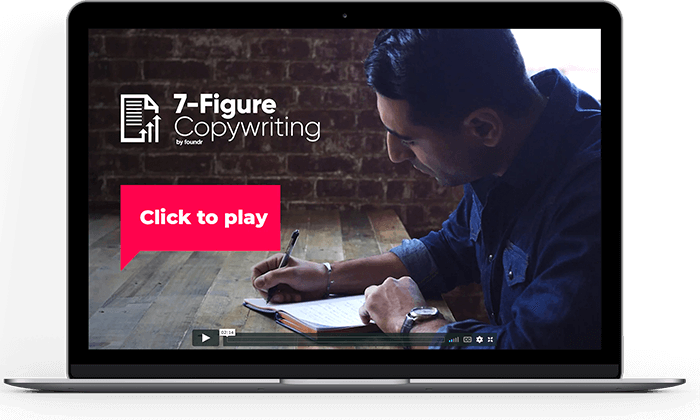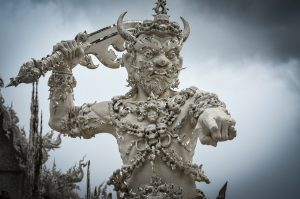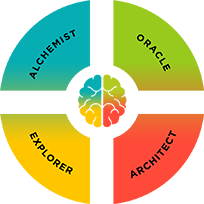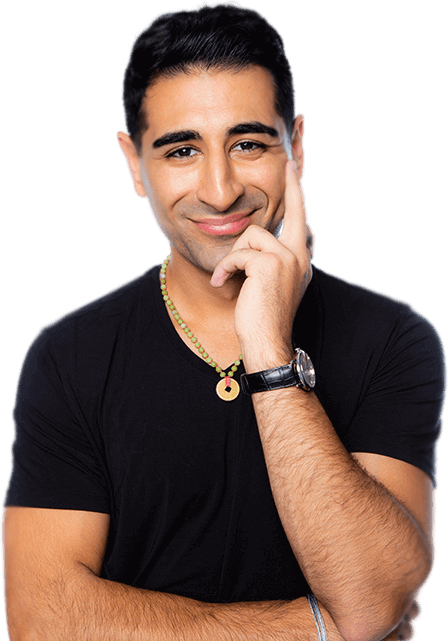Total Reading Time: 10 minutes.
I remember when it finally clicked.
I had just finished creating and launching my first venture as a solopreneur, an online course on email management, Effortless Email, based around some education during my time on the Google Apps team. I was ready to finally start bringing in the sales.
Everything I did was brand new to me. Creating screencast videos, editing, teaching online, understanding marketing psychology, creating landing pages, squeeze pages—I could go on forever, it was all brand new.
Needless to say, I had invested a lot of time and energy. In this excellent personas article by Jodi Harris on Content Marketing Institute, Joe Pulizzi says:
It’s incredibly difficult to monetize an audience of everybody. – Tweet this!
Or as I often say, “If you try and speak to everyone, no one will hear you.”
A persona is an example representation of your perfect buyer/prospect. I overlooked the importance of creating a detailed buyer persona (or avatar). I thought my product appealed to most people in some way, so I never got specific about who it was for. I didn’t understand how important it was to identify a niche within a niche in the market.
Since then, I’ve turned my focus toward writing and blogging. After experimenting in different areas of the online business world, I realized all I wanted to do was read/learn and write/teach. Ultimately everything came back to writing, and so I declared this as my true craft.
Personas Apply for Writers and Bloggers Too
What many writers and bloggers don’t realize is that the same rules apply. If you are writing to please everyone and want to reach the masses, you need to go micro, not macro. In order to find your 1000 true fans, you need to be specific about who you’re speaking to.
As Jeff Goins says in this fantastic post, finding your tribe may be the hardest thing you ever do. But it is also the most important. You must choose and commit to your path, and in my opinion, this is through dedication to self-directed learning. You must pursue mastery (see: video on your vocation and mastery) in whatever craft you choose.
Serving an audience of one eventually creates that tribe, and gives you and your brand a clear voice.
Here are six tips on writing from John Steinbeck, and one brilliant example:
In writing, your audience is one single reader. I have found that sometimes it helps to pick out one person—a real person you know, or an imagined person and write to that one. – John Steinbeck
Defining the Buyer Persona
Whether you are marketing a revolutionary new fitness product, a SaaS product, your awesome new app (related: a free 8 day app business plan), or just writing—it all comes down to understanding your target buyer/lead/audience/reader/client—you get the idea.
So what exactly is a buyer persona? As persona expert Tony Zambito says, the original definition is still important.
Buyer personas are research-based archetypal (modeled) representations of who buyers are, what they are trying to accomplish, what goals drive their behavior, how they think, how they buy, and why they make buying decisions (today, I now include where they buy as well as when buyers decide to buy).
In other words, it’s all about their buying behavior.
Getting Started with Personas
If you haven’t yet created your avatar/persona, now is the time. Buffer blog content crafter extraordinaire Kevan Lee has created an in-depth beginner’s guide on marketing personas. This includes a template and step-by-step guide.
Ultimately you’ll want to identify your personas: name, demographics, job, goals, challenges, values, and fears. It’s important that you go into detail and that you continually keep this updated.
If you have multiple projects and audiences you’re trying to reach, you do need to have separate personas. In general though, I strongly advise against working on multiple projects or businesses at the same time.
It’s critical to have only one brand promise.
Over the years this has been the number one mistake I’ve observed amongst entrepreneurs. Even the successful ones struggle with this, as it eventually causes burnout and a lack of focus. If you have to cut the cord on something, do it now before it becomes painful to do later.
If you’re bouncing from idea to idea, don’t worry, you’re not the only one. I did it too. Many of the most successful people “burn their bridges“, and you should too once you understand why.
Example: The Freedom Lifestyle Insider Persona/Avatar
With the theme of being even more transparent and providing insights on my adventures as a solopreneur, below I’ll be sharing the exact reader persona I’m writing for here on the site.
Whenever I set out to do something, I begin with a research phase and begin consuming and dissecting the most valuable information available on a topic. Next, I generally prefer to come up with my own solution, which combines the best pieces from my research—along with an Arman twist, which generally makes things more straightforward and palatable.
You can use this template as a guide and just replace my text with your own. I saved this in Evernote and often refer to it when I need to reconnect to my one reader, Anthony.
Meet My Persona/Avatar: Anthony

Name: Anthony
Age: 28
Occupation: Business Development – Corporate
Location: Silicon Valley, CA
Hobbies: Travel, reading, writing, podcasts, technology, and sports
Income: $100,000/year
Online habits: Anthony spends most of his time reading about entrepreneurship, technology, productivity, and personal growth. He’s interested in optimizing his lifestyle and creating more freedom for himself. Even though he’s not an entrepreneur yet, he loves learning about it because he’s fascinated and wants to absorb as much as he can before he makes the leap.
Biggest source of pain:
- Imbalance: He struggles to find a balance for himself between his current life and entrepreneurial dreams.
- His inner voice says to be free and move on, but his fear and logic stop him.
- He’s scared of the unknown, and worried about financial problems if things don’t work out.
Biggest hopes and dreams: To be a very successful entrepreneur and bestselling author. To know he’s living an adventurous and fulfilled life. To know with certainty that he’s contributing beyond himself.
Why does he want to have freedom and be an entrepreneur: He feels that this is how he will be most fulfilled in life. He’s always felt a desire for something more and feels limited working for someone else.
What are his biggest opportunities (including ones he doesn’t know about yet):
- Create and launch an online business in one of the top areas: software, information products, ecommerce, consulting/coaching— e.g., doesn’t know that he can have the software developed for him
- Build a thriving online business around his lifestyle of travel and adventure
- Build an influential online brand/community
- Write a book and become a bestselling author—doesn’t know that he can write a bestselling book and believes only people with connections can
Favorite websites: Brain Pickings, Inc.com, The Art of Non Conformity, Wait But Why, Lifehacker, TechCrunch, and ArmanAssadi.com 🙂
Social Media: Facebook is his main outlet. He uses LinkedIn for work. He follows people he admires on Twitter, uses Instagram, and plays around with Snapchat. He’s open to new technology and is generally an early adopter.
Description: Anthony is a sharp, outgoing, friendly, positive guy. He’s not married, but he’s in a happy relationship with a supportive girlfriend. Anthony has always felt different, and sees the world from a unique perspective. He has huge dreams, most of which he keeps a secret. He knows he’s capable of making them all come true and deeply wants to keep the fire within alive. He’s always been told he as a ton of potential. He struggles to find a balance for himself between his current life and entrepreneurial dreams.
He’s successful, paid well, and gets his work done. Nonetheless, he’s always wanted to be an entrepreneur, but he’s not sure what his craft should be. Even before reading The Four Hour Workweek he had dreams of forging his own path, but he settled with a traditional career path because it was the right thing to do. He absolutely loves to travel, and that’s a big reason why he wants to work for himself. He values freedom above everything else. More than every other value in life he wants the freedom to do what he wants, when he wants, how we wants, and even with whom he wants.
As an extrovert, he enjoys being around other people and loves to help his friends. He wants to contribute something valuable to the world and leave a legacy. His enthusiasm is contagious, and many people consider him an inspiring person. He loves to write, and has strong ideals that he stands firmly for. He’s always dreamed of becoming an author. When he does work that excites him, he feels alive. Unfortunately, this almost always is temporary and he feels like a cog in a machine. He’s never legitimately tried being an entrepreneur, but he thinks he’s capable and would have the work ethic and focus to be successful.
He’s scared of the unknown, and worried about financial problems if things don’t work out. He doesn’t worry about not working hard enough, but doesn’t want to sacrifice his current lifestyle too much. He would like to build an online business and receive passive income from it. In the long-term he would build a virtual team and manage his business from anywhere in the world. He doesn’t want to dabble, and is more interested in doing things the right way and building a sustainable company. He feels that this is how he will be most fulfilled in life.
Create Your Persona and Check It Twice
You can always take this further. Once you have your first draft, feel free to go into more detail. If you already have your persona or avatar complete, it’s important to keep it updated and continue iterating as your brand develops.
Heidi Cohen suggests looking through a 12 point checklist to make sure you’ve covered all the various aspects of a marketing persona. I particularly liked this question from Heidi, “what do they want from your company?”. This is a critical question that will help you lead the entire exercise back to how you can best create value for them.
Benefits of Having a Strong Persona
Once you’ve created all this, what can you expect in return? Well, for one, you can expect to begin connecting with your audience on a whole new level. Engagement will likely increase across all fronts, and you’ll begin to win your first true fans.
You’ll also begin to find that your prospects/leads are your #1 source for feedback. When it’s time to create a new product or service, these are the people you need to be connecting with and surveying.
Lauren Sorenson put together a very thoughtful, short post on the HubSpot blog about 6 core insights/benefits a well-defined marketing persona can bring your business, including how to leverage each one.
Conclusion
Creating a marketing persona is a must. Skipping this critical step usually leads to frustration from not being able to connect with your buyers/prospects. You’ll find that when you create a persona or avatar and adapt your messaging, your audience will become more engaged.
Many writers assume that they can and should just write freely, but this often leads to an audience where no one is listening. This is even more important for product creators or service providers. Your persona should be specific, and there are a few criteria you must answer. There are also some frameworks you can follow, and you should plan on continually updating your persona over time.
- –
Photo credit: Unfinished Business
Do you already have a persona or avatar for your business? If so, please share the process for how you discovered yours in the comments so others can learn too. If you don’t have one yet, I’d love to hear the initial idea for yours. You can even share his/her name too…






